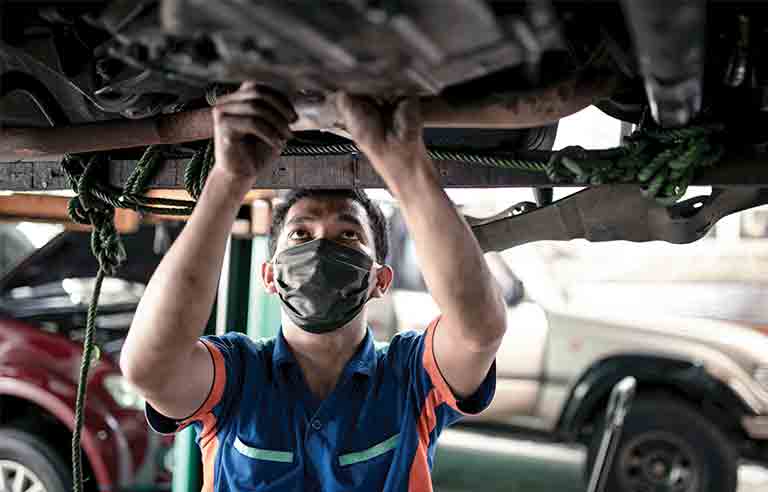OSHA Violations Are AvoidableOSHA Violations Are Avoidable
Begin by evaluating the current state of your workplace to locate areas where you can improve conditions for your employees.
August 12, 2021

When it comes to OSHA compliance, auto dealers and repair shops are often cited for the same list of common violations. Here are the top five, in order:
Hazard Communication
Respiratory Protection
Electrical Systems
Powered Industrial Trucks a.k.a. Forklifts
Personal Protective Equipment
The best way to address OSHA rules is to become familiar with them. To help you get started, here’s why each may be an issue for auto dealers and what you can do to ensure your dealership and repair shop stay in compliance with OSHA.
Violation No.1: Failure to Meet the Hazard Communication Standard
OSHA’s Hazard Communication Standard is founded on the premise that employees have a right to know the identity of the hazardous chemicals to which they are exposed in the workplace and the physical and health hazards associated with them.
The Hazard Communication Standard was aligned with the Globally Harmonized System for Classification and Labeling of Chemicals in 2012, resulting in changes to previous compliance methods.
Risk is present wherever chemicals are, whether employees handle them directly or not. For any workers who may be exposed, directly or indirectly, to hazardous chemicals, you must:
Make safety data sheets available to employees for every onsite chemical.
Maintain a written hazard communication plan.
Provide hazard communication training (Right to Know) for workers who may be exposed to hazardous chemicals.
Provide resources for chemicals to be properly labeled, regardless of container type or storage method.
Violation No.2: Inadequate Respiratory Protection
If the workplace contains hazardous levels of dust, fumes or contaminants, OSHA requires that employers assess and minimize these hazards, if possible, using engineering and administrative controls.
If these steps don’t provide adequate protection, you must provide workers with respiratory devices (a.k.a. “respirators”) to be used in accordance with OSHA’s standards on respirator use, maintenance and inspection.
To stay in compliance, dealers and repair shops should:
Know respiratory standards that apply to their jobsite.
Document all required respiratory procedures.
Regularly evaluate respiratory standards and equipment.
Ensure employees are healthy enough to wear respirators through medical evaluations.
Train employees on respirator procedures and fit test them to ensure that respirators are properly fitting.
Provide access to adequate medical treatment.
Violation No.3: Incorrect Labeling of Electrical Systems
Electrical systems in the workplace expose employees to risk of electrical shock, whether they’re working directly on the system, on equipment plugged into the system or simply are flipping switches.
Electrical systems on location must comply with all OSHA guidelines and relevant building codes.
If you’re not sure how this regulation might apply in your facility, consider whether your employees install, update or perform maintenance on electrical systems, including in vehicles or maintenance equipment, whether it is owned by the dealership or the employee itself.
If the answer is yes, this applies to your jobsite.
Violation No.4: Improper Use of Powered Industrial Trucks
Powered industrial trucks, better known as forklifts, are a common source of workplace injuries and OSHA violations. The two most common issues related to forklifts are pedestrian accidents and tipping due to imbalanced loads or excessive speed but can be managed by ensuring the following are completed:
Train all employees, certify all forklift operators.
Inspect forklifts before every use.
Areas where these vehicles will be operated should be well lit.
Drivers should observe speed limits, wear safety belts and use horns as recommended.
Violation No.5: Insufficient Personal Protective Equipment
Personal Protective Equipment (PPE) is the last resort of protection for your employees when you can’t protect them using protocols or other equipment. As an employer in the automotive industry, you’re responsible for the following:
Completing a hazard assessment for all employees.
Providing the proper PPE and ensuring employees use it correctly.
Correctly maintaining PPE.
Communicating to employees, through signage or training, when PPE is required.

Micah OShaughnessy_Headshot (1)
Begin by Assessing the Hazards in Your WorkplaceWhatever the scope of your dealership or auto repair services, it’s critical to the success of your business that you follow OSHA’s guidelines for workplace safety and remain in compliance with their standards.
To this end, you must begin by evaluating the current state of your workplace to locate areas where you can improve conditions for your employees. Compliance is an ongoing process, standards change, and safe operations are a shared responsibility for you and your employees every day.
Micah O'Shaughnessy (pictured, above left) is a regulatory project manager at KPA, an Environmental, Health & Safety (EHS) and workforce compliance software and services provider for midsize businesses.
About the Author
You May Also Like